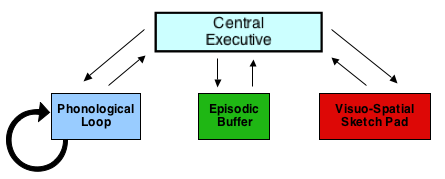The working memory model discussed earlier has a lot going for it compared to other memory models. Here are a few things:

The working memory model.
1) Unlike some other models (eg, the short-term store model), the working memory model explains not only the storage, but also the processing of information.
2) Specificity. Because the model proposes specific and separate functions and subsystems, new predictions and hypotheses can be drawn up for testing.
3) It is consistent with records of brain-damaged patients. For example the visuo-spatial sketch pad is said to be made of two parts, the visual cache which stores information about colour and form, and the inner scribe, which processes spatial and movement information. Patient ‘LH’ had more difficulty with visual tasks than spatial tasks, which probably means that there is a different part of the brain controlling these things; just as the model suggests (1). Another example is ‘KF’, whose forgetting of auditory stimuli was higher than visual stimuli. (2) There are quite a few cases like this, which support the model.
4) The model integrates a large number of research findings. As well as studies on brain damaged patients, there is also experimental evidence which supports the model (eg., Baddeley and his colleagues’ word-length effect (3) supporting the phonological loop), and a number of brain-scan studies have found different brain regions to activate when people carry out tasks involving the different components of working memory (4; this paper and many others are available for download here).
5) A previous model placed enormous importance on verbal rehearsal for transferring information into long-term memory; this doesn’t match up well with our day-to-day experience. In the working memory model, verbal rehearsal is noted as one way to encode and store information, but there are other routes too (visual stimuli, the episodic buffer, etc). From this point of view, it’s more realistic.
6) The working memory has a strong role in cognitive psychology and can be used to study other theorised systems and processes in the brain (eg., consciousness), by seeing how they relate to working memory. A perfect example of this, is how the central executive allows researchers to look into how memory relates to attention.
There you go, six starting points for the evaluation section of any essay or exam you might have on this topic, or more detailed information for people who are just plain interested. By they way, if you’re a psychology student, you may also be interested in my study skills book!
References:
(1) Farah, M.J., Hammond, K.H., Levine, D.N. & Calvanio, R. (1988). Visual and spatial mental imagery: Dissociable systems of representation. Cognitive Psychology, 20, 439-462.
(2) Shallice, T., & Warrington, E. K. (1970). Independent functioning of verbal memory store: A neuropsychological study. Quarterly Journal of Experimental Psychology, 22, 261–273.
(3) Baddeley, A.D. et al. (1975). Word length and the structure of short-term memory. Journal of Verbal Learning and Verbal Behavior 14, 575–589.
(4) Sala, J.B., Rama, P., & Courtney, S.M. (2003). Functional Topography of a Distributed Neural System for Spatial and Nonspatial Information Maintenance in Working Memory. Neuropsychologia, 41(3), 341-56.
Recommended Reading:
Comments
2 responses to “6 Strengths of the working memory model”
What useful information it is! Thanks for writing this information. Relating to memory, do you know how to improve memory?
A few ideas:
https://generallythinking.com/3-keys-to-fantastic-memory/